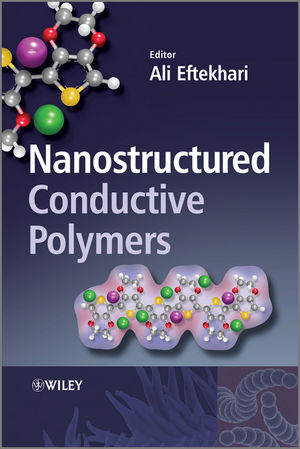Nanostructured Conductive PolymersISBN: 978-0-470-74585-4
Hardcover
800 pages
August 2010
 This is a Print-on-Demand title. It will be printed specifically to fill your order. Please allow an additional 15-20 days delivery time. The book is not returnable.
|
||||||
Foreword.
List of Contributors.
Part One.
1 History of Conductive Polymers (J. Campbell Scott).
1.1 Introduction.
1.2 Archeology and Prehistory.
1.3 The Dawn of the Modern Era.
1.4 The Materials Revolution.
1.5 Concluding Remarks.
2 Polyaniline Nanostructures (Gordana Ciric-Marjanovic).
2.1 Introduction.
2.2 Preparation.
2.3 Structure and Properties.
2.4 Processing and Applications.
2.5 Conclusions and Outlook.
3 Nanoscale Inhomogeneity of Conducting-Polymer-Based Materials (Alain Pailleret and Oleg Semenikhin).
3.1 Introduction: Inhomogeneity and Nanostructured Materials.
3.2 Direct Local Measurements of Nanoscale Inhomogeneity of Conducting and Semiconducting Polymers.
3.3 In situ Studies of Conducting and Semiconducting Polymers: Electrochemical Atomic Force Microscopy (EC-AFM) and Electrochemical Scanning Tunneling Microscopy (EC-STM).
3.4 The Origin of the Nanoscale Inhomogeneity of Conducting and Semiconducting Polymers.
Part Two.
4 Nanostructured Conductive Polymers by Electrospinning (Ioannis S. Chronakis).
4.1 Introduction to Electrospinning Technology.
4.2 The Electrospinning Processing.
4.3 Electrospinning Processing Parameters: Control of the Nanofiber Morphology.
4.4 Nanostructured Conductive Polymers by Electrospinning.
4.5 Applications of Electrospun Nanostructured Conductive Polymers.
4.6 Conclusions.
5 Composites Based on Conducting Polymers and Carbon Nanotubes (M. Baibarac, I. Baltog, and S. Lefrant).
5.1 Introduction.
5.2 Carbon Nanotubes.
5.3 Synthesis of Composites Based on Conducting Polymers and Carbon Nanotubes.
5.4 Vibrational Properties of Composites Based on Conducting Polymers and Carbon Nanotubes.
5.5 Conclusions.
6 Inorganic-Based Nanocomposites of Conductive Polymers (Rabin Bissessur).
6.1 Introduction.
6.2 FeOCl.
6.3 V2O5 Systems.
6.4 VOPO4.2H2O.
6.5 MoO3.
6.6 Layered Phosphates and Phosphonates.
6.7 Layered Rutiles.
6.8 Layered perovskites.
6.9 Layered Titanates.
6.10 Graphite Oxide.
6.11 Conclusions.
7 Metallic-Based Nanocomposites of Conductive Polymers (Vessela Tsakova).
7.1 Introduction.
7.2 Oxidative Polymerization Combined with Metal-Ion Reduction (One-Pot Synthesis).
7.3 Nanocomposite Formation by Means of Pre-Synthesized Metal Nanoparticles.
7.4 Metal Electrodeposition in Pre-Synthesized CPs.
7.5 Chemical Reduction of Metal Ions in Pre-Polymerized CP Suspensions or Layers.
7.6 Metallic-Based CP Composites for Electrocatalytic and Electroanalytic Applications.
8 Spectroscopy of Nanostructured Conducting Polymers (Gustavo M. do Nascimento and Marcelo A. de Souza).
8.1 Synthetic Metals.
8.2 Nanostructured Conducting Polymers.
8.3 Spectroscopic Techniques.
8.4 Spectroscopy of Nanostructured Conducting Polymers.
8.5 Concluding Remarks.
9 Atomic Force Microscopy Study of Conductive Polymers (Edgar Ap. Sanches, Osvaldo N. Oliveira Jr, and Fabio Lima Leite).
9.1 Introduction.
9.2 AFM Fundamentals and Applications.
9.3 Concluding Remarks.
10 Single Conducting-Polymer Nanowires (Yixuan Chen and Yi Luo).
10.1 Introduction.
10.2 Fabrication of Single Conducting-Polymer Nanowires (CPNWs).
10.3 Transport Properties and Electrical Characterization.
10.4 Applications of Single Conducting Polymer Nanowires (CPNWs).
10.5 Summary and Outlook.
11 Conductive Polymer Micro- and Nanocontainers (Jiyong Huang and Zhixiang Wei).
11.1 Introduction.
11.2 Structures of Micro- and Nanocontainers.
11.3 Preparation Methods and Formation Mechanisms.
11.4 Properties and Applications of Micro- and Nanocontainers.
11.5 Conclusions.
12 Magnetic and Electron Transport Behaviors of Conductive-Polymer Nanocomposites (Zhanhu Guo, Suying Wei, David Cocke, and Di Zhang).
12.1 Introduction.
12.2 Magnetic Polymer Nanocomposite Preparation.
12.3 Physicochemical Property Characterization.
12.4 Microstructure of the Conductive Polymer Nanocomposites.
12.5 Interaction between the Nanoparticles and the Conductive-Polymer Matrix.
12.6 Magnetic Properties of Conductive-Polymer Nanocomposites.
12.7 Electron Transport in Conductive-Polymer Nanocomposites.
12.8 Giant Magnetoresistance in Conductive-Polymer Nanocomposites.
12.9 Summary.
13 Charge Transfer and Charge Separation in Conjugated Polymer Solar Cells (Ian A. Howard, Neil C. Greenham, Agnese Abrusci, Richard H. Friend, and Sebastian Westenhoff).
13.1 Introduction.
13.2 Charge Transfer in Conjugated Polymers 534
13.3 Charge Generation and Recombination in Organic Solar Cells with High Open-Circuit Voltages 545
13.4 Conclusions and Outlook 555
Part Three.
14 Nanostructured Conducting Polymers for (Electro)chemical Sensors (Anthony J. Killard).
14.1 Introduction.
14.2 Nanowires and Nanotubes.
14.3 Nanogaps and Nanojunctions.
14.4 Nanofibers and Nanocables.
14.5 Nanofilms.
14.6 Metallic Nanoparticle/Conducting-Polymer Nanocomposites.
14.7 Metal-Oxide Nanoparticles/Conducting-Polymer Nanocomposites.
14.8 Carbon Nanotube Nanocomposites.
14.9 Nanoparticles.
14.10 Nanoporous Templates.
14.11 Application Summaries.
14.12 Conclusions.
15 Nanostructural Aspects of Conducting-Polymer Actuators (Paul A. Kilmartin and Jadranka Travas-Sejdic).
15.1 Introduction.
15.2 Mechanisms and Modes of Actuation.
15.3 Modelling Mechanical Performance and Developing Device Applications.
15.4 Effect of Morphology and Nanostructure upon Actuation.
15.5 Solvent and Ion Size Effects to Achieve Higher Actuation.
15.6 Nanostructured Composite Actuators.
15.7 Prospects for Nanostructured Conducting-Polymer Actuators.
16 Electroactive Conducting Polymers for the Protection of Metals against Corrosion: from Micro- to Nanostructured Films (Pierre Camille Lacaze, Jalal Ghilane, Hyacinthe Randriamahazaka and Jean-Christophe Lacroix).
16.1 Introduction.
16.2 Protection Mechanisms Induced by Conducting Polymers.
16.3 Conducting-Polymer Coating Techniques for Usual Oxidizable Metals: Performances of Conducting-Polymer-Based Micron-Thick Films for Protection against Corrosion.
16.4 Nanostructured Conducting-Polymer Coatings and Anticorrosion Protection.
16.5 Conclusions.
17 Electrocatalysis by Nanostructured Conducting Polymers (Shaolin Mu and Ya Zhang).
17.1 Introduction.
17.2 Electrochemical Synthetic Techniques of Nanostructured Conducting Polymers.
17.3 Electrocatalysis at Nanostructured Conducting-Polymer Electrodes.
17.4 Conclusion.
18 Nanostructured Conductive Polymers as Biomaterials (Rylie A. Green, Sungchul Baek, Nigel H. Lovell, and Laura A. Poole-Warren).
18.1 Introduction.
18.2 Biomedical Applications for Conductive Polymers.
18.3 Polymer Design Considerations.
18.4 Fabrication of Nanostructured Conductive Polymers.
18.5 Polymer Characterization.
18.6 Interfacing with Neural Tissue.
18.7 Conclusions.
19 Nanocomposites of Polymers Made Conductive by Nanofillers (Haiping Hong, Dustin Thomas, Mark Horton, Yijiang Lu, Jing Li, Pauline Smith, and Walter Roy).
19.1 Introduction.
19.2 Experimental.
19.3 Results and Discussion.
19.4 Conclusion.
Acknowledgments.
References.
Index.



